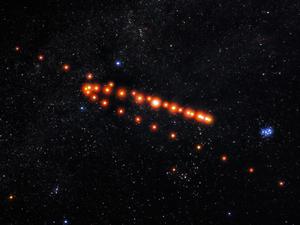Glossary term: 衝
Description: 當兩個天體在觀測者看來排成一條直線或接近一條直線,並且在天空中位於相反方向時,謂之為“沖”。觀測者並不需要能同時看到這兩個物體。例如,在滿月時,太陽、地球上的觀測者和月亮排成一線,因此月亮可見部分的表面完全被太陽照亮——除非三者完美對齊,在這種情況下會發生月食。當行星、彗星或小行星處於沖時,通常是指與太陽和地球上的觀測者的關係。當行星處於沖時,它將顯得特別明亮,在移動方向上出現“逆行”(因為地球在其較內側軌道上移動得更快),並且離地球特別近。
Related Terms:
See this term in other languages
Term and definition status: The original definition of this term in English have been approved by a research astronomer and a teacher The translation of this term and its definition is still awaiting approval
This is an automated transliteration of the simplified Chinese translation of this term
The OAE Multilingual Glossary is a project of the IAU Office of Astronomy for Education (OAE) in collaboration with the IAU Office of Astronomy Outreach (OAO). The terms and definitions were chosen, written and reviewed by a collective effort from the OAE, the OAE Centers and Nodes, the OAE National Astronomy Education Coordinators (NAECs) and other volunteers. You can find a full list of credits here. All glossary terms and their definitions are released under a Creative Commons CC BY-4.0 license and should be credited to "IAU OAE".
If you notice a factual or translation error in this glossary term or definition then please get in touch.
Related Media
火星逆行
Credit: Rob Kerby Guevarra/IAU OAE (CC BY 4.0)
License: CC-BY-4.0 Creative Commons 姓名標示 4.0 國際 (CC BY 4.0) icons









